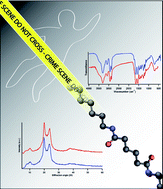Polymers on the crime scene: How can analytical chemistry help to exploit the information from these mute witnesses?
Abstract

* Corresponding authors
a
Dipartimento di Scienze Chimiche, Università di Padova, via Marzolo 1, Padova, Italy
E-mail:
valerio.causin@unipd.it
Fax: +390498275161
Tel: +390498275215

 Please wait while we load your content...
Something went wrong. Try again?
Please wait while we load your content...
Something went wrong. Try again?
V. Causin, Anal. Methods, 2010, 2, 792 DOI: 10.1039/C0AY00115E
To request permission to reproduce material from this article, please go to the Copyright Clearance Center request page.
If you are an author contributing to an RSC publication, you do not need to request permission provided correct acknowledgement is given.
If you are the author of this article, you do not need to request permission to reproduce figures and diagrams provided correct acknowledgement is given. If you want to reproduce the whole article in a third-party publication (excluding your thesis/dissertation for which permission is not required) please go to the Copyright Clearance Center request page.
Read more about how to correctly acknowledge RSC content.
 Fetching data from CrossRef.
Fetching data from CrossRef.
This may take some time to load.
Loading related content
